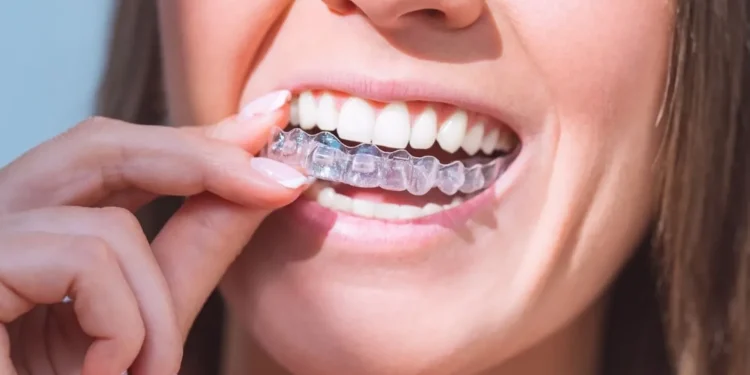Invisalign, a clear aligner system, has emerged as a preferred method to straighten teeth without the visibility of traditional braces. Many consider Invisalign a solution that preserves confidence during treatment by eliminating metal brackets and wires. For those in search of a cosmetic dentist London residents trust, this approach to teeth alignment offers a subtle way to address crooked, crowded, or misaligned teeth.
According to leading London cosmetic dentist Dr. Sahil Patel of Marylebone Smile Clinic, “Invisalign treatment is changing the way patients approach orthodontics, as the aligners are both removable and practically invisible. This brings a new level of comfort and discretion compared to conventional braces. If you require more detailed insights or wish to explore the process further, I recommend checking our Invisalign info for comprehensive information and personalised advice.” Over the past decade, this clear aligner option has seen dramatic acceptance among professionals, students, and busy parents alike, primarily because of its adaptability to different lifestyles.
Understanding how Invisalign works, why it is essential to maintain proper oral alignment, and how London clinics tailor treatment to British residents can help people decide whether to pursue this method. This article explores the technology behind Invisalign, the patient journey from consultation to results, and the broader effects of clear aligners on dental health and personal confidence. It also addresses considerations such as cost and lifestyle impact, helping readers evaluate whether Invisalign is the right fit for their circumstances. Advancements in modern dentistry and the growing awareness of cosmetic treatments have positioned Invisalign as a viable alternative that combines function, comfort, and subtlety. Below is an in-depth look at how this system fits into London’s extensive range of orthodontic and cosmetic dental options.
Understanding the Invisalign System
To appreciate the appeal of Invisalign, one needs to understand its basic mechanics. Instead of bracket-and-wire braces that rely on fixed metal attachments, Invisalign uses a series of custom-made clear aligners. Each aligner is specifically designed to apply gentle pressure in just the right places to gradually shift teeth into a more desirable position. The process involves digital imaging software that captures an accurate mould of a patient’s mouth, making it possible for dentists to predict and plan movements at each stage.
One of the standout advantages of Invisalign is the precise fit it offers. Because the aligners are mapped according to digital scans, they fit snugly, providing consistent pressure while remaining comparatively comfortable. Patients switch to a new set of aligners every one to two weeks, following a carefully designed progression. The entire treatment length can vary, with mild cases sometimes completing in under a year, while more complex cases may require 18 months or longer. The adaptability of each aligner to the specific phase of movement maximises efficiency, helping many people achieve better alignment in a predictable timeframe.
Moreover, each aligner is made of a strong but thin thermoplastic that is practically invisible. This clear, wafer-thin mould conforms to the shape of the teeth, making the aligners more comfortable to wear than bulkier alternatives. Many appreciate that they can speak and smile with confidence, as friends or colleagues might not notice the aligners at first glance. While some initial lisp or slight discomfort is normal when adapting to new trays, most patients report that these issues are short-lived and far less distracting than traditional braces.
The Importance of Proper Alignment
Teeth alignment is not solely about aesthetics. Although having straight teeth can improve the look of a smile, there are significant health implications associated with orthodontic correction. Misaligned teeth may create uneven bite forces, leading to potential difficulties such as jaw pain or excessive wear on specific teeth. They can also make oral hygiene more challenging. Gaps, overlaps, or crowding can trap food and make brushing and flossing less effective, thereby increasing the risk of gum disease and tooth decay. By achieving proper alignment, patients often discover benefits that extend beyond a more appealing appearance, including improved chewing efficiency and a potentially lower risk of developing dental complications later on.
Invisalign can offer these structural advantages without the social or psychological drawbacks that sometimes accompany metal braces. Traditional braces, although effective, may cause self-consciousness in personal, academic, or professional environments. Clear aligners reduce the visibility of corrective treatment and, in some cases, allow patients to remove them briefly for special occasions or when playing sports (with a protective mouthguard). This flexibility often encourages better compliance, as individuals are more motivated to wear the aligners consistently when they do not feel self-conscious.
Furthermore, improved alignment can help with speech clarity. Certain speech impediments or difficulties can be attributed in part to misaligned teeth or a poor bite. While many factors influence speech, realigning teeth can have a positive impact for some people. It also helps build self-esteem. Knowing that one’s teeth are being optimally shifted into place often provides a sense of progress and optimism, further contributing to the general popularity of Invisalign in London clinics.
The Invisalign Process in London
In London, the Invisalign process typically begins with an initial consultation. Dentists or orthodontists who provide Invisalign will evaluate whether a patient’s concerns can be effectively managed with this system. Not all cases of severe misalignment are suitable, but advances in aligner technology now accommodate many moderate to even complex cases that once required fixed braces. If a patient is found suitable, a thorough examination, including digital scans or impressions, will be carried out. These are then used to create a customised treatment plan.
The next step involves generating a sequence of aligners that the patient will wear in a prescribed order. By following the dentist’s instructions, which generally involve wearing the aligners for at least 20 to 22 hours a day, the teeth will shift through incremental phases. Patients often return to the clinic every four to six weeks for progress checks and to collect the next sets of aligners. Throughout this period, communication between the dentist and the patient is crucial, as adjustments or refinements may be needed. Sometimes attachments, tiny tooth-coloured bumps placed on certain teeth, are added to enhance grip for more intricate movements.
London’s vibrant dental care scene means that patients have access to multiple providers, from private clinics in areas like Marylebone to larger establishments across the city. While the process remains fundamentally the same, the overall patient experience can differ based on a clinic’s specific approach, additional services, and the level of personalised care they provide. That said, the typical Invisalign journey is uniform enough that those seeking discreet teeth alignment can confidently choose a qualified provider and benefit from a standard of excellence that London-based clinics often uphold.
Maintenance and Aftercare
An integral aspect of a successful outcome with Invisalign involves proper maintenance of both the aligners and one’s overall oral hygiene. Because the aligners are removable, they should be taken out during meals and when drinking anything other than water. This avoids the possibility of staining or damaging the plastic. After eating, it is best to brush the teeth before reinserting the trays, preventing food debris from becoming trapped and lowering the likelihood of plaque buildup.
Cleaning the aligners daily is also recommended. Gentle brushing with a soft toothbrush and mild soap or using a dedicated aligner-cleaning solution can keep them in good condition. By keeping the trays clean, patients maintain their near-invisibility and avoid unpleasant odours. Good oral hygiene habits such as thorough brushing and flossing become easier with Invisalign, as patients do not have to navigate wires or brackets. However, diligence remains key. The combined effect of aligner cleanliness and conscientious oral care supports healthy gums and a sparkling smile once treatment is complete.
After the final set of aligners has done its job, most Invisalign patients transition to a retainer. Retainers help ensure that teeth remain in their newly aligned positions, as teeth can shift over time if not properly stabilised. The retainer stage is an essential part of the process; without it, the teeth risk moving back towards their original state. With consistent use, however, most patients enjoy long-lasting results and find that the retainer quickly becomes a simple part of their nightly routine.
Accessing Invisalign in London
London’s reputation as a global city means it boasts a high standard of healthcare, including dentistry. Many clinics offer Invisalign as part of their cosmetic and orthodontic services. While some individuals discover these clinics through personal recommendations, others rely on research, reading reviews, or exploring online resources. Finding a reputable dentist, particularly one experienced with Invisalign, helps ensure a smoother journey and more satisfying results.
Cost and treatment duration tend to be among the primary considerations when deciding on Invisalign. London’s array of clinics provides a range of pricing structures, which can vary based on the complexity of the case, the dentist’s level of expertise, and any additional services included in a package (such as whitening or bonding). Payment plans or financing options are also available at many practices, making Invisalign more accessible to a broader patient base. Because the aligner system has gained significant popularity, potential patients are generally able to locate a clinic that meets their budget and timeline preferences.
In addition, Londoners often benefit from flexible appointment schedules that cater to their busy lives. Many clinics open early or close later in the evening, helping professionals who might find it difficult to break away from work. Some offices even operate on weekends. This adaptability reflects the modern trend of patient-focused dentistry, ensuring that seeking treatment does not become an undue burden. From the initial consultation to routine check-ups, London clinics often strive to accommodate diverse lifestyles while maintaining high standards of care.
Potential Limitations and Considerations
Though Invisalign is widely regarded as an effective treatment, it is not without limitations or considerations. For instance, individuals must be disciplined enough to wear their aligners for the recommended hours each day. Removing the aligners for extended periods can hinder progress and lead to suboptimal results. Additionally, patients with severely rotated teeth or certain bite issues may require alternative orthodontic approaches, although continual improvements to aligner technology are closing this gap.
Another factor involves potential discomfort. While the lack of metal brackets significantly reduces irritation to the cheeks and gums, new aligners can cause mild soreness or pressure as the teeth adjust to each shifting stage. Most find this discomfort manageable, akin to the tightness experienced after braces are tightened. It is also worth noting that good oral health is a prerequisite for starting Invisalign. Issues such as untreated cavities or gum disease must be resolved before commencing treatment to avoid exacerbating underlying problems.
Compliance plays a large role in treatment success. Forgetting to wear the aligners or failing to transition to the new set on schedule can prolong overall treatment time. Additionally, because the aligners are removable, there is always the risk of misplacing or accidentally throwing them away after meals. Many patients adopt routines—like storing the aligners in a designated case whenever they are not worn—to minimise the risk of losing them.
The Cost Factor
The perceived costliness of Invisalign often prompts questions about value and affordability. Traditionally, treatments like metal braces might appear cheaper, particularly within the context of the NHS for younger patients who qualify. However, in many cases, adults do not meet the NHS’s eligibility criteria for orthodontic coverage, or they prefer a more subtle treatment than that offered by traditional braces. This is where Invisalign’s unique selling points come into play, potentially making its cost worthwhile.
Several factors influence Invisalign pricing. The complexity of the patient’s orthodontic condition is a major determinant. Someone with minor tooth movement needs fewer aligners and fewer office visits, leading to a lower overall cost, whereas more complicated cases can be pricier. Additionally, a clinic’s location in London’s more affluent areas can come with higher overhead costs, and thus might quote higher fees. Payment arrangements, financing plans, or promotions (especially for new patients) can make the investment more accessible. Some individuals also find that their private dental insurance offers partial coverage or reimbursement for orthodontic treatments.
In the broader scheme, patients weigh cost against the benefits of an almost invisible treatment that does not disrupt their social or professional life. Many aligner users note that their career, confidence, and daily routine remained uninterrupted throughout the treatment phase, factors that they believe justify the expense. Understanding the value of comfortable treatment, fewer restrictions on food, and minimal interference with appearance can help patients assess whether this approach aligns with their priorities.
Real Stories from Invisalign Patients
Some of the strongest endorsements for Invisalign come from those who have completed the process or are undergoing treatment. Many cite renewed confidence as a key advantage. People who once hesitated to smile openly in photos due to crooked or overlapping teeth find themselves smiling effortlessly after treatment. The subtle nature of the aligners can also reduce anxiety among those who were anxious about wearing visible braces as adults.
Another frequently mentioned benefit involves convenience. Because the aligners are removable, patients appreciate not having to adapt their dietary habits significantly. This is especially relevant in a food-loving city like London, where an active social life often involves restaurants and cafes. With Invisalign, one simply removes the aligners to enjoy a meal and then brushes and reinserts them afterward. There is no need to worry about food getting stuck in brackets or wires.
Many also find that the consistent progression of aligners provides tangible milestones. Switching from one set of trays to the next becomes a small achievement on the path to a better smile. Moreover, digital technology used to plan treatment can often show patients a projected outcome, offering motivation to comply with the aligner schedule. Although each person’s journey is unique, these common threads of convenience, confidence, and predictability illustrate why so many in London are drawn to this method of orthodontic correction.
The Future of Orthodontics in London
Invisalign’s success is part of a broader shift in dentistry towards technologically advanced solutions that enhance both function and aesthetics. As scanning software and 3D printing capabilities evolve, aligners become more precise, comfortable, and efficient. Orthodontic providers in London continue to adopt these innovations, reinforcing the city’s position as a hub for cutting-edge dental care. Treatments are likely to become more tailored to individual patient needs, with more accurate digital simulations and the possibility of direct remote monitoring.
Moreover, the concept of cosmetic dentistry is expanding beyond simply improving one’s smile to addressing overall health and well-being. Clinics often integrate complementary treatments, such as whitening, contouring, or even facial aesthetics, in conjunction with Invisalign. This integrated approach caters to patients seeking a comprehensive makeover that extends beyond straight teeth. In many cases, such synergy streamlines the patient experience, reducing the total number of visits and ensuring consistent aesthetic and functional improvements.
As more people of varying ages pursue orthodontic care, the stigma once associated with braces has diminished. Clear aligners have played a significant role in this shift, showing that teeth-straightening can be discreet, convenient, and efficient at almost any stage of life. With continuing innovations in aligner materials and scanning technologies, future generations of Invisalign treatments may address an even wider array of alignment issues, making them accessible to nearly everyone who desires them.
Conclusion
Invisalign represents a modern approach to teeth alignment that combines technology, comfort, and discretion. Its rising popularity among Londoners can be attributed to several factors. The transparent design makes it a versatile option for those wanting orthodontic treatment without drawing attention. The convenience of removable aligners encourages better oral hygiene and a more flexible lifestyle. The digital treatment planning ensures each movement is mapped out, offering patients predictability and control over their orthodontic journey.
Yet, beyond the aesthetics and convenience, Invisalign provides tangible health benefits. Improved alignment can reduce the risk of tooth decay, gum disease, and bite problems, ensuring that patients reap the rewards of both function and beauty. Though it requires commitment—wearing the aligners as prescribed and maintaining diligent oral hygiene—the payoff, for many, is a smile that inspires self-assurance.
In a city as dynamic as London, where personal presentation and confidence often intersect with professional and social demands, Invisalign fits well with the desire for subtle, high-quality solutions. Modern clinics across the city provide professional support, personalised treatment plans, and post-treatment care, enabling patients to navigate the process seamlessly. With a dedicated approach and a willingness to follow the recommended guidelines, most individuals find the experience rewarding from start to finish.
As technology continues to enhance dentistry, clear aligners like Invisalign are poised to remain at the forefront of cosmetic and orthodontic care. People of varying ages and lifestyles are discovering that achieving a straighter smile no longer has to involve conspicuous brackets or prolonged treatment durations with limited dietary options. Instead, Invisalign offers a minimally invasive way to transform smiles while maintaining day-to-day confidence—a valuable proposition for anyone seeking to make a positive change without disrupting their busy London life.














